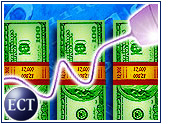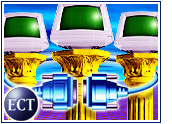
Hard-to-visualize functionality, extremely complex feature descriptions, an invisible presence in the network, and boring names, taken together, sum up why the enterprise Ethernet switching market does not get nearly the attention it deserves.
But Ethernet switching is a multibillion-dollar market that CIOs spend a lot of time scrutinizing. And although the market is on the same rough road as other technology products, there are some bright spots. What do IT execs need to know about the big business of high-tech switching?
Down or Up?
According to the Dell’Oro Group, the Ethernet switch market declined 4 percent worldwide in 2002.
“The market is flat at best,” Yankee Group vice president Zeus Kerravala told the E-Commerce Times. “We’re not seeing any growth.”
IDC research manager Abner Germanow agreed, telling the E-Commerce Times that “there was tremendous purchasing in 2000, [but] a lot of companies who spent very heavily on networking equipment have stopped capital expenditures.”
However, there is light on the horizon: Sales are projected to increase from US$11.3 billion in 2002 to $16 billion in 2007.
Falling Prices
Complicating matters is the fact that prices of many switching products are falling fast. Consider 10-Gigabit Ethernet switches. Their average price has fallen from $70,000 two years ago to $30,000 last year to less than $10,000 this year, according to Kerravala. With those drop rates, why would an enterprise run out to buy the latest and greatest switch?
“For the most part, companies don’t need that much bandwidth,” Kerravala noted. “They’re not tapping out their … networks right now.” However, that could change if desktop voice and video applications gather some traction in enterprises, he noted.
Price drops also make measuring the market more complex. The number of switching ports shipped actually has leaped 30 percent in the last two quarters, Gartner principal analyst Rachna Ahlawat told the E-Commerce Times, although measured by revenue the market has been flat to slightly down. Overall, shipments will increase 5 to 6 percent in 2003, she said, while revenue will be flat or down 1 to 2 percent.
Business Reasons Required
As a result of the slow market, vendors must come up with compelling business reasons for buyers to take the plunge, such as including a platform that supports IP telephony or building intelligence into the network, Kerravala said.
“In 1999, you could upgrade a switch because you needed more bandwidth; today you need a very solid business reason,” Germanow said. “The key is an application that’s bandwidth intensive,” such as streaming video or medical imaging.
Power over Ethernet (PoE) switching is one feature recently added to Cisco’s Catalyst 6500 line. POE means the switch can send both electrical power and data over the same connection. Using such a switch, an enterprise can power voice over IP devices and wireless LAN access points. Foundry recently introduced a switch that delivers 480 watts of PoE across switch ports using a single power supply.
Demand for wireless LAN products could have a spillover effect into the switching market, Germanow said. As enterprises upgrade their wireless networks, they will look at new wireless LAN switches, which enable administrators to centrally manage large numbers of access points.
“As companies look to integrate wireless and wired networks, those boxes that help that integration become very valuable,” he explained. However, he noted, it is too early to tell “whether they [will] end up as separate boxes or as features and functionality on the switch.”
Layered Differences
Other factors also may spur sales of certain types of switches. The total number of ports shipped for Layer 3 switches has increased in the past year, Ahlawat said, because companies deploying streaming video and multicasting want to make their networks more efficient by deploying virtual LANs. Because these new Layer 3 switches have enough features to support such multimedia applications but not enough to be part of the core of a network, they also cost less.
Layer 4-7 switches, also called Web switching appliances, also may see some pickup later in the year, Ahlawat said. In 1999, when these products were first introduced, vendors jumped on the dot-com bandwagon without knowing what enterprises needed, Ahlawat said. But now vendors have improved their products and packaging. “These appliances are able to take care of a lot of security issues,” she noted. “They help protect infrastructure and help direct traffic coming to a Web site to different servers.” That is important for enterprises concerned with load balancing and caching issues.
Playing Hard
The fact that the market is so bad and that it is dominated by a single vendor means there is an increasingly intense battle among the remaining sellers to gain market share. Cisco still maintains its stranglehold, with more than 70 percent of overall share. There really is not a “de facto” number two, Kerravala said. On the high end, Foundry Networks is Cisco’s chief competitor, while on the low end it is 3Com. Any market share won by a vendor usually comes at the expense of a company other than Cisco, he added.
For example, at least 10 major vendors compete in Ethernet switches — a number too great for the market to support, according to Kerravala. That means Force10 Networks, a startup that develops 10-Gigabit Ethernet switches, will have a tough time competing in this market, even though it recently raised $41 million in venture capital financing. “Their future is really in doubt,” he said.
Fierce Competition
Competition along price lines has been especially fierce, Germanow said. A number of vendors are coming into the low end of the market with equipment that uses merchant silicon — essentially a switch on a chip. Dell is among thosevendors. “Anyone could buy that chip and sell it for a lot less than a Cisco or a Nortel that design custom ASICs,” Germanow said. These low-end pricing wars put pressure on how much high-end products cost, he added.
IP telephony, wireless LANs, streaming video — any and all of these applications could play a role once the switching market bounces back. “It will take a couple of very high-bandwidth applications that are in demand worldwide and that have compelling business uses,” Germanow said. “Whatever spurs the switch market will also spur the hardware and software markets.”
But the recovery will take a while — at least a year, according to Kerravala. Vendors will have ample time to tweak their attack strategies. Perhaps they also could spend that time devising a good name for a switch.













































I have some comments on your article "The Big Business of Network Switches." My comments are listed below.
In your article you state:
"Complicating matters is the fact that prices of many switching products are falling fast. Consider 10-Gigabit Ethernet switches. Their average price has fallen from $70,000 two years ago to $30,000 last year to less than $10,000 this year, according to Kerravala."
This is not correct information. If you look at any complete 10 gig product and add in the required optics to travel any distance (10 Klm to 40 Klm) you will see the cost is more like $100,000. The required optics (1310NM or 1550NM) is double the $10,000 you state for the entire product.
In your article you also state:
"For the most part, companies don’t need that much bandwidth," Kerravala noted. "They’re not tapping out their 10-Gigabit and 100-Gigabit networks right now."
I think you ment to state 10 Mbps and 100 Mbps not 10 Gbps and 100 Gbps. All major Ethernet networks today are either 10 Mbps or 100 Mbps with virtually all new installations being 100 Mbps. More and more 1 Gbps links are being installed and 10 Gbps is beginning to show up in limited qtys. Trials on 40 Gbps are taking place. There is no 100 Gbps. You should point this error out to your readers.